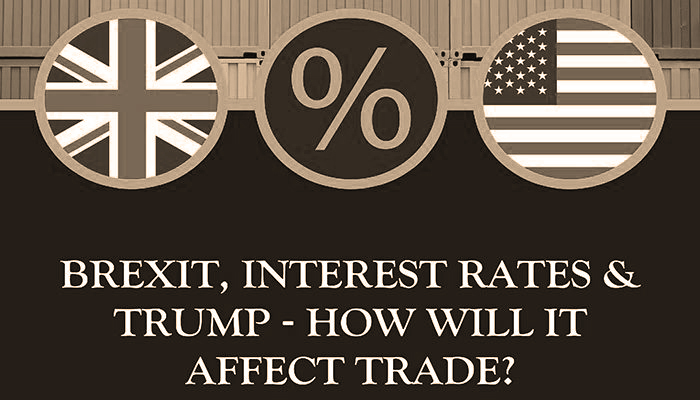Brexit, Interest Rates And Trump – How Does It Affect Trade?

Brexit, Interest Rates and Trump – What’s Next?
It has been a turbulent year on the world stage. We have seen a sea of change in global politics – the UK’s Brexit vote, Donald Trump’s victory in the U.S. Presidential election and the resignation of Italy’s Prime Minister Matteo Renzi after his defeat in a referendum to change the country’s constitution.
These have all had repercussions on the international economy; we have seen the British pound fall in value and turbulent times on the world stock markets. Although we will be starting 2017 with a very different backdrop to which we began in 2016, there will be numerous opportunities for growth in international trade and container shipping in the next 12 months.
Brexit Opportunities
Following the UK’s vote to leave the European Union in June, the Legatum Institute Special Trade Commission (STC) was set up to look at the available trade opportunities.
It recommends that the UK follows an “expansive trade negotiating path”, with help from negotiators from across the US, Canada, Australia, New Zealand, Mexico and Singapore.
The UK’s plans for post-Brexit trade deals should become clearer in 2017, if – as widely expected – the nation’s Prime Minister Theresa May triggers Article 50 in March to begin the official ‘divorce’ proceedings. While a member of the EU, the UK is forbidden to begin individual trade negotiations with other countries but its trade ministers are already holding provisional talks with economic powers across the globe.
In addition to a broad free-trade agreement with the EU, the UK will be looking further afield as it builds its trading partnerships. The Legatum Institute’s Special Trade Commission has pointed to the importance of creating a new prosperity zone of friendly trading countries that support free trade. These are likely to include Commonwealth nations and those in Africa, the Caribbean and Pacific countries. The Institute forecasts that by following this route, the UK will be able to channel an additional 1.5% into the world’s production of goods and services, providing new opportunities for the maritime container sector.
Spotlight on Asia- Pacific
International trade in Asia-Pacific is forecast to remain steady in 2017, despite it being unlikely that the US-led Trans-Pacific Partnership (TTP) free trade deal will be signed. The deal, championed by President Obama, has been dismissed by President Elect Trump, although there have been signs that negotiations are still open.
EU ambassador to the US David O’Sullivan said recently: “We stand ready to continue these negotiations and bring them to a successful conclusion. We still think the objective arguments in favour of a good trans-Atlantic deal remain valid.”
Aside from the TTP, there is growing support in the Asia-Pacific region for the Chinese-backed Regional Comprehensive Economic Partnership (RCEP). Involving the ten members of the Association of Southeast Asian Nations (ASEAN), plus Australia, China, India, Japan, South Korea and New Zealand, it would cover around 45% of the world’s population, which carry out around 40% of international trade. RCEP negotiations are expected to be completed in 2017.
This, along with the UK’s trade negotiations, is likely to see positivity in the container shipment sector, which will be required to grow to meet the demand being created by the new deals on the international agenda.
Source: Davenport Laroche Market Research 03.2017
Image Source: Davenport Laroche Market Research